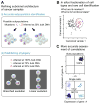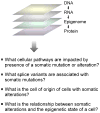High-dimension single-cell analysis applied to cancer
- PMID: 28823596
- PMCID: PMC5780229
- DOI: 10.1016/j.mam.2017.08.005
High-dimension single-cell analysis applied to cancer
Abstract
High-dimension single-cell technology is transforming our ability to study and understand cancer. Numerous studies and reviews have reported advances in technology development. The biological insights gleaned from single-cell technology about cancer biology are less reviewed. Here we focus on research studies that illustrate novel aspects of cancer biology that bulk analysis could not achieve, and discuss the fresh insights gained from the application of single-cell technology across basic and clinical cancer studies.
Keywords: Cell identity; Correlation analysis; Single-cell analysis; Subclone phylogeny; Tumor ecosystem; Tumor heterogeneity.
Copyright © 2017 Elsevier Ltd. All rights reserved.
Figures




References
-
- Aceto N, Bardia A, Miyamoto DT, Donaldson MC, Wittner BS, Spencer JA, Yu M, Pely A, Engstrom A, Zhu H, Brannigan BW, Kapur R, Stott SL, Shioda T, Ramaswamy S, Ting DT, Lin CP, Toner M, Haber DA, Maheswaran S. Circulating tumor cell clusters are oligoclonal precursors of breast cancer metastasis. Cell. 2014;158:1110–1122. doi: 10.1016/j.cell.2014.07.013. - DOI - PMC - PubMed
-
- Akrap N, Andersson D, Bom E, Gregersson P, Stahlberg A, Landberg G. Identification of Distinct Breast Cancer Stem Cell Populations Based on Single-Cell Analyses of Functionally Enriched Stem and Progenitor Pools. Stem Cell Reports. 2016;6:121–136. doi: 10.1016/j.stemcr.2015.12.006. - DOI - PMC - PubMed
Publication types
MeSH terms
Grants and funding
LinkOut - more resources
Full Text Sources
Other Literature Sources

